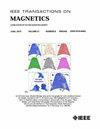Assessing the Resolution of Transcranial Magnetic Stimulation by Measuring the Magnetic Flux Density at the Cortical Surface
IF 1.9
3区 工程技术
Q3 ENGINEERING, ELECTRICAL & ELECTRONIC
引用次数: 0
Abstract
Transcranial magnetic stimulation (TMS) is a noninvasive and localized stimulation technique. Local stimulation is useful for studying brain functions and treating brain disorders. Previous studies have reported a stimulus resolution of approximately 5 mm or a stimulus area smaller than 50 mm2. Stimulus resolution has previously been evaluated using various measurement techniques. In this study, the magnetic flux density measured using a simplified system was analyzed using the quality factor (Q)-value. Magnetic pulses (at 75% intensity) were delivered using a figure-eight-shaped flat coil to a curved-head model. A distance of 15 mm from the stimulus coil to the center of the sensor coil was assumed as the same distance from the scalp to the cortex. The stimulation resolution was evaluated based on the magnetic flux density measured on the surface of the curved-head model, and the size of the stimulation area was evaluated based on the Q value. The results revealed that in both the x- and y-axes directions, the stimulation resolution on the cortical surface was less than 2 mm (通过测量皮质表面磁通密度评估经颅磁刺激的分辨率
经颅磁刺激(TMS)是一种无创的局部刺激技术。局部刺激对于研究脑功能和治疗脑疾病是有用的。先前的研究报道了刺激分辨率约为5毫米或刺激面积小于50平方毫米。刺激分辨率以前已经使用各种测量技术进行了评估。本文采用质量因子(Q)值对简化系统测得的磁通密度进行了分析。磁脉冲(强度为75%)通过一个8字形的扁平线圈传送到一个曲头模型。假设从刺激线圈到传感器线圈中心的距离为15mm,与头皮到皮层的距离相同。根据曲线头模型表面测得的磁通密度评价增产分辨率,根据Q值评价增产面积。结果表明,在x轴和y轴方向上,皮质表面的刺激分辨率均小于2 mm (${p} \lt 0.01$)。从峰值到- 0.1和- 3.0 dB的q值沿x轴和y轴分别约为7.0和0.8和4.0和0.6。这些结果表明,使用弯头模型可以使TMS设备在较窄的分辨率范围内刺激目标,并且可以使用q值轻松评估刺激区域。
本文章由计算机程序翻译,如有差异,请以英文原文为准。
求助全文
约1分钟内获得全文
求助全文
来源期刊

IEEE Transactions on Magnetics
工程技术-工程:电子与电气
CiteScore
4.00
自引率
14.30%
发文量
565
审稿时长
4.1 months
期刊介绍:
Science and technology related to the basic physics and engineering of magnetism, magnetic materials, applied magnetics, magnetic devices, and magnetic data storage. The IEEE Transactions on Magnetics publishes scholarly articles of archival value as well as tutorial expositions and critical reviews of classical subjects and topics of current interest.
 求助内容:
求助内容: 应助结果提醒方式:
应助结果提醒方式:


